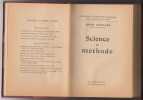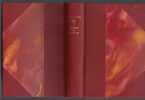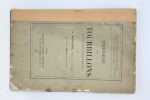-
Type
Book (19871)
Magazine (13)
Manuscript (4)
Maps (1)
Photographs (4)
-
Latest
Last 3 days (4)
Last month (37)
Last week (7)
-
Language
English (43)
French (19839)
German (2)
Japanese (1)
Latin (1)
Polish (2)
Portuguese (1)
Russian (1)
Spanish (1)
Swedish (2)
-
Century
16th (6)
17th (37)
18th (303)
19th (3729)
20th (11875)
21st (1526)
-
Countries
Belgium (361)
Brazil (1)
Côte d'Ivoire (19)
Denmark (1352)
France (18003)
Switzerland (157)
-
Syndicate
ILAB (17292)
NVVA (26)
SLACES (26)
SLAM (15914)
SNCAO (12)
Le livre du centenaire de la naissance de Henri Poincaré. 1854/1954 -- EDITION ORIGINALE
P., Gauthier-Villars, 1955, un volume in 4 relié en cartonnage éditeur, 1 frontispice, (2), 304pp., (1), nombreux documents et photographies
---- EDITION ORIGINALE ---- Discours, allocutions et communications par MM. Julia, Hadamard, L. De Broglie, Borel, Pérès, Weil, Schwartz, Lévy, Beth...**4233/6767/K2
Les deuils de l'Académie des sciences en 1912 : Henri POINCARE in Revue scientifique du 16 Novembre 1912
P., Revue Scientifique, 1912, un volume in 4, broché, couverture imprimée, pp. 628/629
---- EDITION ORIGINALE**4241/L7DE
Science et Méthode
1947 Flammarion, Paris, 1947. Couverture rigide- demi toile à coins, 314 pp, Bibliothèque de Philosophie Scientifique.- relié tete-beche,bon état
Remise de 20% pour toutes commandes égales ou supérieures à 200 €
Sur les courbes tracées sur les surfaces algébriques -- EDITION ORIGINALE -- TIRE-A-PART (OFFPRINT) des annales de l'Ecole Normale supérieure
P., Gauthier-Villars, 1910, un volume in 4, broché, (dos cassé), pp. 55/108
---- EDITION ORIGINALE -- TIRE-A-PART (OFFPRINT) des annales de l'Ecole Normale supérieure ---- DSB XI pp. 51/61**4227/L7DE
Sur les rapports de l'analyse pure et de la physique mathématique -- EDITION ORIGINALE -- TIRE-A-PART (OFFPRINT) des Acta mathematica, tome 21
P., 1897, un volume in 4, broché, couverture imprimée, pp. 331/341
---- EDITION ORIGINALE -- TIRE-A-PART (OFFPRINT) des Acta mathematica, tome 21**5488/6723/L7DE
Une médaille frappée à l'éfigie de Henri Poincaré est remise à Mme Veuve Henri Poincaré et à M. Le Président Raymond Poincaré. Allocutions de M. Le Président et de M. Paul Appel in Comptes rendus hebdomadaires des séances de l'Académie des Sciences, tome 180 N° 13 (30 Mars 1925)
P., Gauthier-Villars, 1925, un volume in 4, broché, couverture imprimée, pp. 977/979
---- EDITION ORIGINALE**4234/6766/L7DE
POINCARE (H.) - Association des anciens élèves des lycées de Nancy, Metz, Strasbourg et Colmar
Reference : 4236
Hommage à Henri Poincaré. 9 Novembre 1913
---- EDITION ORIGINALE ---- Nancy, Colin, 1913, un volume in 4, broché, couverture imprimée, 1 frontispice, 29pp., 4 planches hors texte**4236/6764/L7DE
Capillarité - Leçons professées pendant le deuxième semestre 1888-1889 (Cours de la Faculté des sciences de Paris, Cours de physique mathématique)
Paris, Georges Carré 1895 189pp., 1e édition, 26cm., br.orig. (dos renforcé) protégé par papier cristal, peu de rousseurs, W82089
Institut de France. Discours prononcés ... pour la réception de M. Henri Poincaré le 28 janvier 1909.
Paris, Typographie de Firmin Didot et Cie, 1909 ; plaquette in-4°, demi-percaline gris-vert chiné à la bradel, fleuron et date dorés au dos, titre doré sur étiquette de maroquin brun, couverture conservée, tête dorée ( A. Mertens relieur); 70pp.Titre et dernier feuillet blanc uniformément jaunis, ainsi que les bords de la couverture (acidité du papier de couverture).
Henri Poincaré prenait la place de Sully-Prudhomme. Son discours de réception occupe les pages 3 à 37, suit la “ Réponse de Frédéric Masson au discours de M. Henri Poincaré " (pp.39-70). Edition originale. (CO2)
LECONS SUR LES HYPOTHESES COSMOGONIQUES PROFESSEES A LA SORBONNE
Librairie Scientifique A. Hermann & Fils. 1913. In-8. Relié demi-cuir. Bon état, Couv. convenable, Dos à nerfs, Quelques rousseurs. 294 pages. Photo en noir et blanc en frontispice (portrait). Auteur, titre et roulettes dorés sur le dos. Etiquette de code sur le dos. Tampons de bibliothèque en page de titre.. . . . Classification Dewey : 510-Mathématiques
2e édition avec un portrait en héliogravure et une Notice par Ernest Lebon. 'Cours de la Faculté des Sciences de Paris'. Rédigé par Henri Vergne. Classification Dewey : 510-Mathématiques
Théorie des tourbillons - Leçons professées pendant le deuxième semestre 1891-1892
Sceaux, Editions Jacques Gabay, 1990, in-8 br. (16 x 24), 211 p., réimpression de l'édition de 1893, leçons rédigées par M. Lamotte, très bon état.
"On a tenté aussi de trouver, dans l'existence de pareils mouvements tourbillonnaires, l'explication mécanique de l'univers. Au lieu de se représenter l'espace occupé par des atomes que séparent des distances immenses vis - à-vis de leurs propres dimensions, sir William Thomson admet que la matière est continue, mais que certaines portions sont animées de mouvements tour billonnaires, qui, d'après le théorème de Helmholtz, doivent conserver leur individualité". Voir le sommaire sur photos jointes.
Théorie des tourbillons. Leçons professées pendant le deuxième semestre 1891-92. Rédigées par M. Lamotte, licencié ès-sciences.
P., Georges Carré, 1893 ; fort in-8 broché. 2 ff.-211 pp.- 1p. (erratum). Dos renforcé de papier blanc, couverture fragilisée avec des manques et déchirures.
EDITION ORIGINALE
CALCUL DES PROBABILITES, LECONS PROFESSEES PENDANT LE 2e SEMESTRE 1893-1894
Georges Carré, Paris. 1896. In-8. Relié demi-cuir. Etat d'usage, Couv. convenable, Dos très frotté, Intérieur acceptable. 274 pages. Auteur, titre, fleurons et filets dorés sur le dos. Etiquette de code sur le dos. Tampons de bibliothèque en page de titre.. . . . Classification Dewey : 510-Mathématiques
'Cours de la Faculté des Sciences de Paris', par l'Association amicale des élèves et anciens élèves de la Faculté. Rédigé par A. Quiquet, ancien élève de l'ENS. Classification Dewey : 510-Mathématiques
Calcul des Probabilitiés
Editions Jacques Gabay 2000 333 pages 16x2x23 6cm. 2000. Broché. 333 pages.
Bon Etat couverture un peu défraîchie intérieur propre fac simile de l'édition de 1912
La valeur de la science. Les sciences mathématiques ; les sciences physiques ; la valeur objective de la science.
Paris, E. Flammarion 1935. Bel exemplaire broché, couverture ornée d'éd., in-8, 278 pages.
Remarques diverses sur l'équation de Fredholm.
[Berlin, Stockholm, Paris, Beijer, 1910] 4to. Without wrappers as extracted from ""Acta Mathematica. Hrdg. von G. Mittag-Leffler."", Bd. 33, pp. 57-86.
First printing of Poincaé's work on Fredholm's equation.""... heuristic variational arguments convinced Poincaré that there should be a sequence of ""eigenvalues"" and corresponding ""eigenfunctions"" for this problem, but for the same reasons lit was not able to prove their existence. A few years later, Fredholm's theory of integral equations enabled him to solve all these problems"" it is likely that Poincareé's papers had a decisive influence on the development of Fredholm's method, in particular the idea of introducing a variable complex parameter in the integral equation. It should also be mentioned that Fredholm's determinants were directly inspired by the theory of ""infinite determinants"" of H. von Koch, which itself was a development of much earlier results of Poincaré in connection with the solution of linear differential equations."" (DSB)
Remarques diverses sur l'équation de Fredholm.
Berlin, Uppsala & Stockholm, Paris, Almqvist & Wiksell, 1909. 4to. Bound in contemporary half cloth with gilt lettering to spine. In ""Acta Mathematica"", Vol, 33, 1909. Entire volume offered. Stamps to title page, otherwise a fine and clean copy. pp. 195-200.[Entire volume: (6), 392, 12 pp].
First printing of Poincaé's work on Fredholm's equation.""... heuristic variational arguments convinced Poincaré that there should be a sequence of ""eigenvalues"" and corresponding ""eigenfunctions"" for this problem, but for the same reasons lit was not able to prove their existence. A few years later, Fredholm's theory of integral equations enabled him to solve all these problems"" it is likely that Poincareé's papers had a decisive influence on the development of Fredholm's method, in particular the idea of introducing a variable complex parameter in the integral equation. It should also be mentioned that Fredholm's determinants were directly inspired by the theory of ""infinite determinants"" of H. von Koch, which itself was a development of much earlier results of Poincaré in connection with the solution of linear differential equations."" (DSB)
Remarques sur les intégrales irrégulières deséquations linéaires.
Berlin, G. Reimer, 1887. 4to. Bound in contemporary half cloth with gilt lettering to spine. In ""Acta Mathematica"", Vol, 10, 1887. Entire volume offered. Stamps to title page, otherwise a fine and clean copy. Pp. 310-12. [Entire volume: (4), 397 pp].
First printing of Poincaré's reply to Thomé's critique of an earlier paper by Poincaré. In his reply Poincaré ""seems to have created a theory of asymptotic expansions where previously there had only been ad hoc techniques, and to have opened the door for the return into rigorous mathematics of divergent series."" (Bottazzini, Hidden Harmony).
Sur la méthode horistique de Gyldén. - [POINCARÉ ON GYLDÉN'S HORISTIC METHODS]
Berlin, G. Reimer, 1905, 4to. Bound in contemporary half cloth with gilt lettering to spine. In ""Acta Mathematica"", Vol, 29, 1905. Entire volume offered. Stamps to title page, otherwise a fine and clean copy. Pp. 235-72. [Entire volume: (4), 433 pp].
First printing of Poincaré's final and most extensive paper on Gyldén's horistic methods.
Sur les rapports de l'analyse pure et de la physique mathématique.
[Berlin, Stockholm, Paris, F. & G. Beijer, 1897]. 4to. Without wrappers as extracted from ""Acta Mathematica. Hrdg. von G. Mittag-Leffler."", Bd. 21. No backstrip. Fine and clean. Pp. 331-341.
First printing of Poincaré's principal address at the first International Congress of Mathematicians held in Zürich in 1897.
Sur L'Uniformisation des Fonctions Analytiques. - [THE UNIFORMIZATION THEOREM]
Berlin, Stockholm, Paris, Almqvist & Wiksell, 1908. 4to. Bound in contemporary half cloth with gilt lettering to spine. In ""Acta Mathematica"", Vol, 31, 1908. Entire volume offered. Stamps to title page, otherwise a fine and clean copy. Pp. 1-64. [Entire volume: (8), 408, (2), 12 pp].
First appearance of Poincaré's important paper in which he presented the first solution to the problem of the uniformization of curves - now know as The Uniformization Theorem. Clebsch and Riemann tried to solve the problem of the uniformization for curves. ""In 1882 Klein gave a general uniformization theorem, but the proof was not complete. In 1883 Poincaré announced his general uniformization theorem but he too had no complete proof. Both Klein and Poincaré continued to work hard to prove this theorem but no decisive result was obtained for twent-five years. In 1907 Poincare (in the offered paper) and Paul Koebe independently gave a proof of this uniformization theorem...With the theorem on uniformization now rigorously established an improved treatment of algebraic functions and their integrals has become possible."" (Morris Kline).
Sur l'équilibre d'une masse fluide animée d'un mouvement de rotation. - [POINCARÉ'S PEAR-SHAPE]
(Stockholm, Beijer), 1885. 4to. As extracted from ""Acta Mathematica, 21. Band]. No backstrip. Fine and clean. Pp. 259-380.
First printing of Poincaré's famous paper in which he proved that a rotating fluid such as a star changed its shape from a sphere to an ellipsoid to a pear-shape before breaking into two unequal portions. ""This work, which contained the discovery of new, pear-shaped figures of equilibrium, aroused considerable attention because of its important implications for cosmogony in relation to the evolution of binary stars and other celestial bodies."" (The Princeton Companion to Mathematics, P. 786)Another famous paper of Poincaré in celestial mechanics is the one he wrote in 1885 on the shape of a rotating fluid mass submitted only to the forces of gravitation. Maclaurin had found as possible shapes some ellipsoids of revolution to which Jacobi had added other types of ellipsoids with unequal axes, and P. G. Tait and W. Thomson some annular shapes. By a penetrating analysis of the problem, Poincaré showed that still other ""pyriform"" shapes existed. One of the features of his interesting argument is that, apparently for the first time, he was confronted with the problem of minimizing a quadratic form in ""infinitely"" many variables."" (DSB)
Sur une Forme nouvelle des Équations du Probleme des trois Corps (+) Sur les rapports de l'analyse pure et de la physique mathématique.
Berlin, Uppsala & Stockholm, Paris, Almqvist & Wiksell, 1897. 4to. Bound in contemporary half cloth with gilt lettering to spine. In ""Acta Mathematica"", Vol, 21, 1897. Entire volume offered. Stamps to title page, otherwise a fine and clean copy. pp. 83-97"" Pp. 331-341.[Entire volume: (6), 376 pp + 4 plates].
First printing of this paper in which Poincaré arrives at a new theorem about canonical transformation, and in his later ""Methodes Nouvelles"", he proved this theorem using a variiational principle of mechanics, known today as the Hamilton principle.Also included is the first printing of Poincaré's principal address at the first International Congress of Mathematicians held in Zürich in 1897.
Sur un theoreme de M. Fuchs.
Stockholm, Beijer, 1885. 4to. As extracted from ""Acta Mathematica, 21. Band]. No backstrip. Fine and clean. Pp. 83-97.
First printing of Poincaré's paper in which he developed the idea published by Fuchs in 1884. Fuchs established that the equation with fixed branch points can be made into a Riccati equation if its genus - the genus of the corresponding Riemann surface - with respect to u and du/dz is zero and can be integrated using elliptic functions if the genus is 1.
Rapport sur le Prix Bolyai. - [POINCARÉ APPRAISAL OF HILBERT]
Berlin, G. Reimer, 1912. 4to. Bound in contemporary half cloth with gilt lettering to spine. In ""Acta Mathematica"", Vol, 35, 1912. Entire volume offered. Stamps to title page, otherwise a fine and clean copy. Pp. 1-28. [Entire volume: (4), 398, (1), 27, 19 pp].
First appearance of Poincaré's report on 1910 Bolyai Prize which was awarded to David Hilbert in recognition of his work in fields of invariant theory, transcendent number (e constant after Lindemann), arithmetic, the (Hilbert-)Waring theorem, geometry, integral equations and the Dirichlet’s principle.In 1910, Hilbert became only the second winner of the Bolyai Prize of the Hungarian Academy of Sciences. It was the recognition of the fact that Hilbert was one of the leading mathematicians of his time. The first winner of the prize in 1905 was Henri Poincare, the most prolific mathematician of the 19th century.Poincaré about the works and achievements of David Hilbert in fields of invariant theory, transcendent number (e constant after Lindemann), arithmetic, the (Hilbert-)Waring theorem, geometry, integral equations and the Dirichlet’s principle.
 Write to the booksellers
Write to the booksellers








